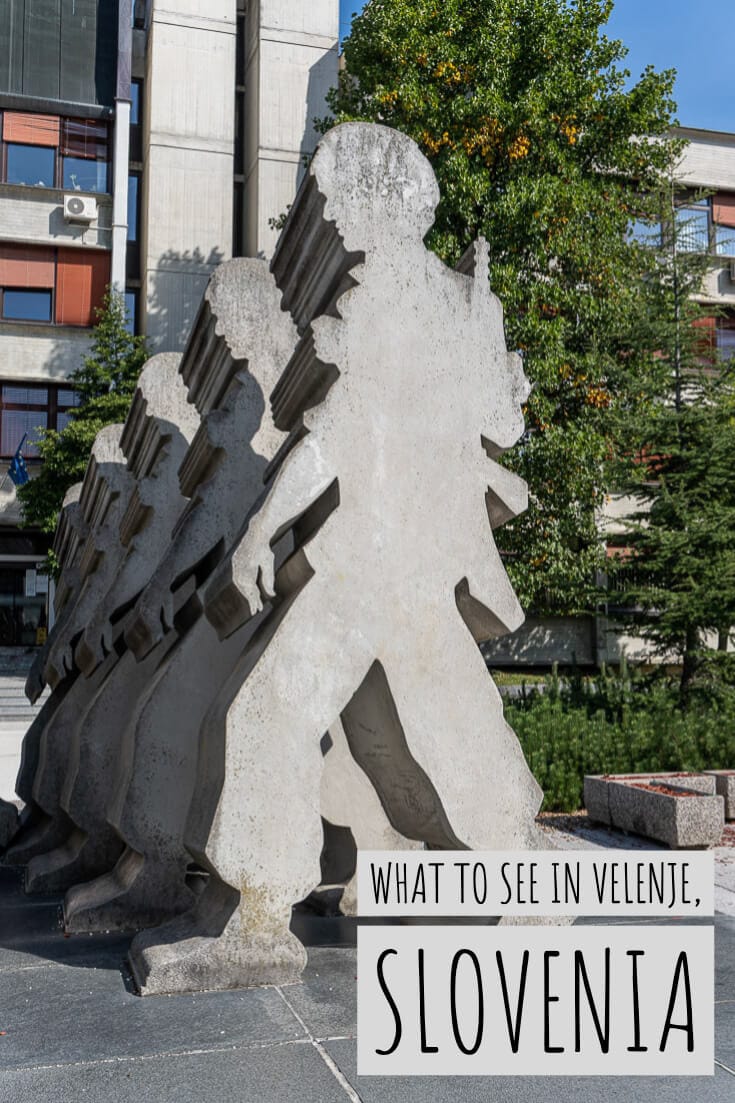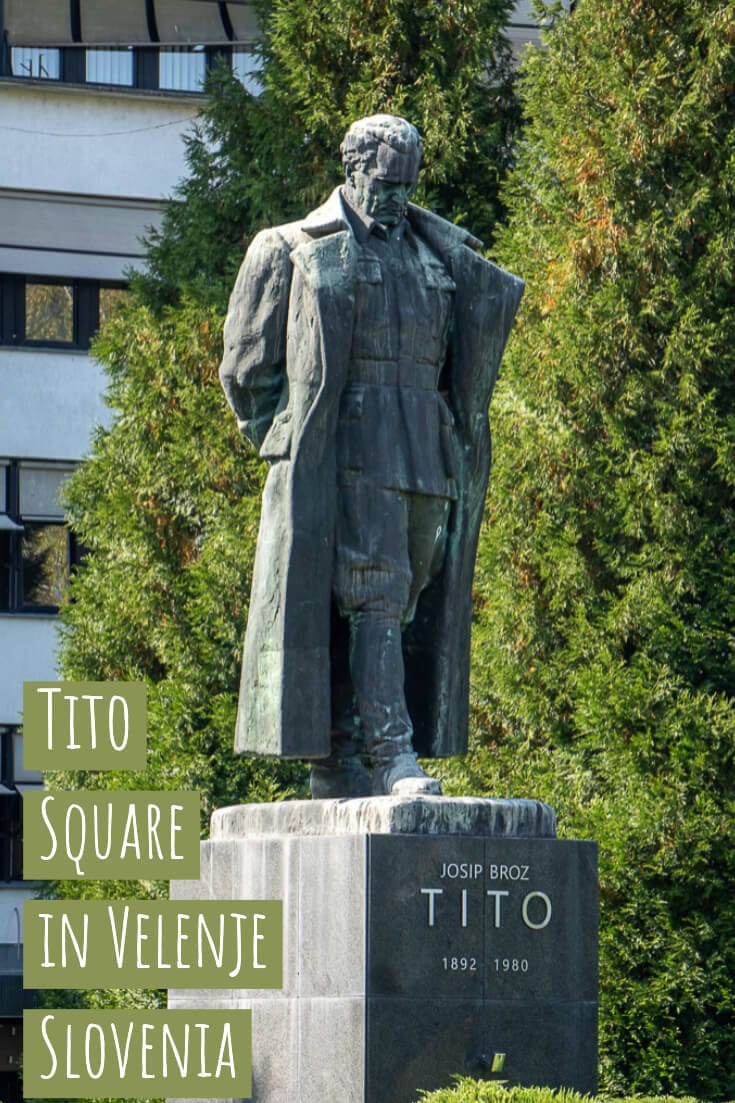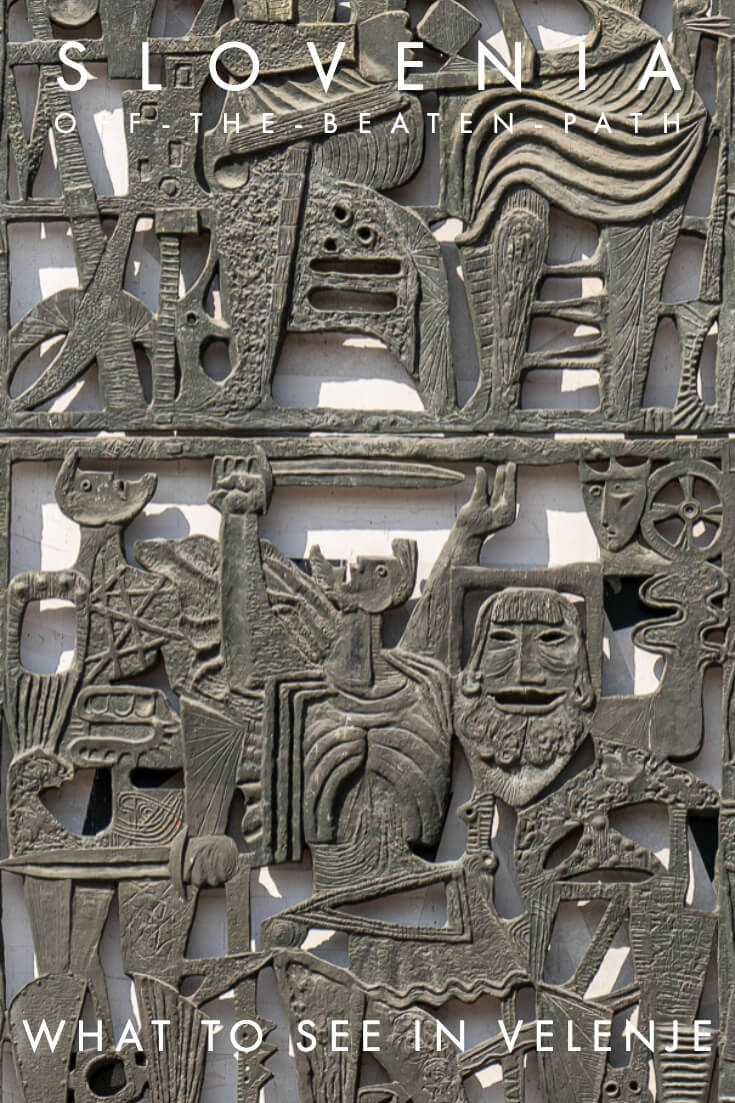Known as Titovo Velenje (Tito’s Velenje) between 1981 and 1990 in honour of the former Yugoslav leader, Slovenia’s sixth-largest city is home to one of the most impressive socialist-era town squares we have seen anywhere in the former Yugoslavia.
Velenje’s history as a settlement can be traced back to the mid-13th-century and even as late as the early 1900s the place was still a small market community located at the foot of the castle with little over 350 citizens. It was the discovery of lignite, or brown coal as it is more commonly known, prior to the start of the National Liberation War (World War Two) that kicked-started Velenje’s expansion into a city. After the war ended, like many pre-existing urban areas in the newly formed Socialist Federal Republic of Yugoslavia, Velenje was developed along the lines of a planned city and during the 1950s it grew at a rapid pace
At the heart of the city’s urban development is the central Tito Square, a wondrous piece of socialist-era planning that doesn’t massively look that different today from what it did some sixty-odd years back at its conception. Original blueprints for the modernisation of the city were modest but when Tito himself got wind of the fact that the new and ambitious director of Velenje’s lignite mine, Nestl Žgank, had doubled the output, lowered production costs and increased profits all within the space of a couple of years, those plans were shelved in favour of something more majestic. Inspired by a German city that Žgank had once visited, Velenje’s new expansion was tasked to Janez Trenz, a Slovenian urban planner, and an Austrian architect called Paul Filipsky. The construction work took place as such a pace that, at one point, work was halted because the contractors temporarily ran out of building materials. Furthermore, and no doubt because of envy, the rapid growth of Velenje received a reasonable amount of opposition from the powers-that-be in Ljubljana.
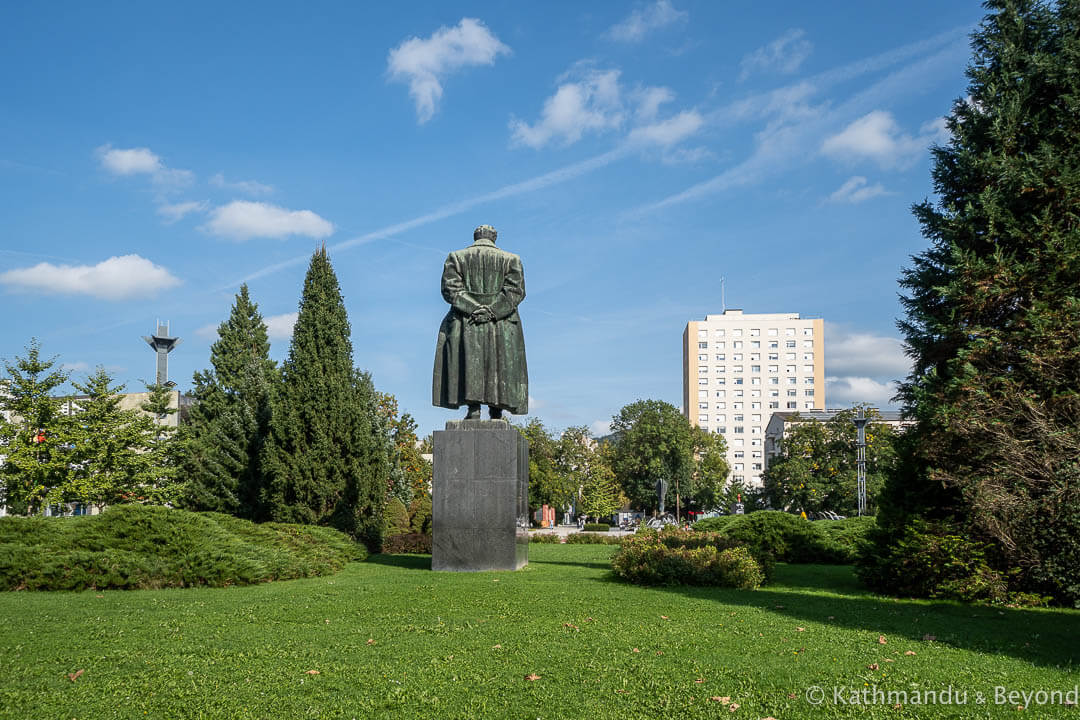
These days, Tito Square in Velenje is most famous for one thing (see below) but, during the period of socialism in Slovenia, it was used as the location for not only major events and celebrations but also for quite a few gatherings of important dignitaries and political leaders from the Soviet bloc, including Nikita Khrushchev and Leonid Brezhnev as well as the former Romanian dictator, Nicolae Ceaușescu.
What there is to see on Tito Square in Velenje
I’ll begin by saying that some of the information below is courtesy of some handy signage/information boards that are positioned close to the places of interest on Tito Square. The boards are in English as well as Slovene and provide a short explanation about the relevant building/monument in question.
Monument to Josip Broz Tito
Not surprisingly, the most striking sculpture on the square is the huge statue of Tito. Although the square was officially opened in 1959, the sculpture was not erected until 1977. Wearing a military uniform and his trademark winter coat, this bronze likeness of the Yugoslavian leader stands on the western edge of the square surrounded by greenery and flowers. Albeit larger, the sculpture is a replica of the statue of Tito that can be found in his birth town of Kumrovec in Croatia. That one was erected in 1947 and now resides within the open-air Old Village Museum in Kumrovec.
As for Velenje’s/ the square’s claim to fame … at six meters high, plus another four metres for the pedestal, it is the tallest statue of Tito in the world.
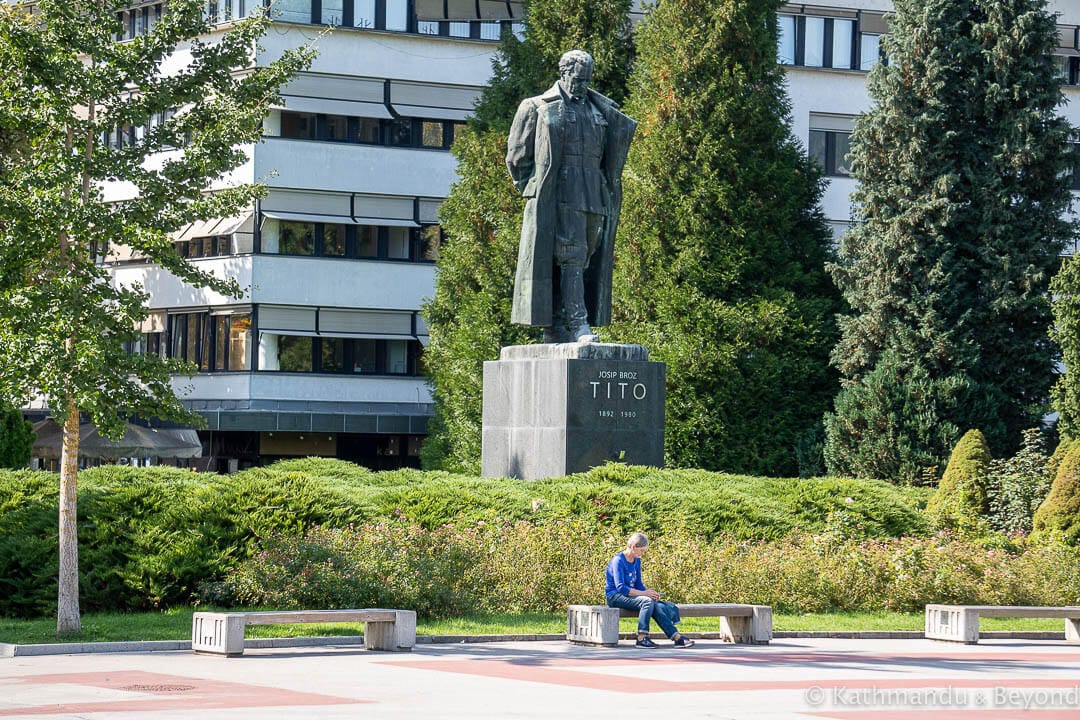 Monument to Josip Broz Tito
Monument to Josip Broz Tito
Public Institution Gallery
Heading in a clockwise direction around the square, next up is the Public Institution Gallery. Renovated in 2015, the original modernist 1971 building is still very much a main feature of the square.
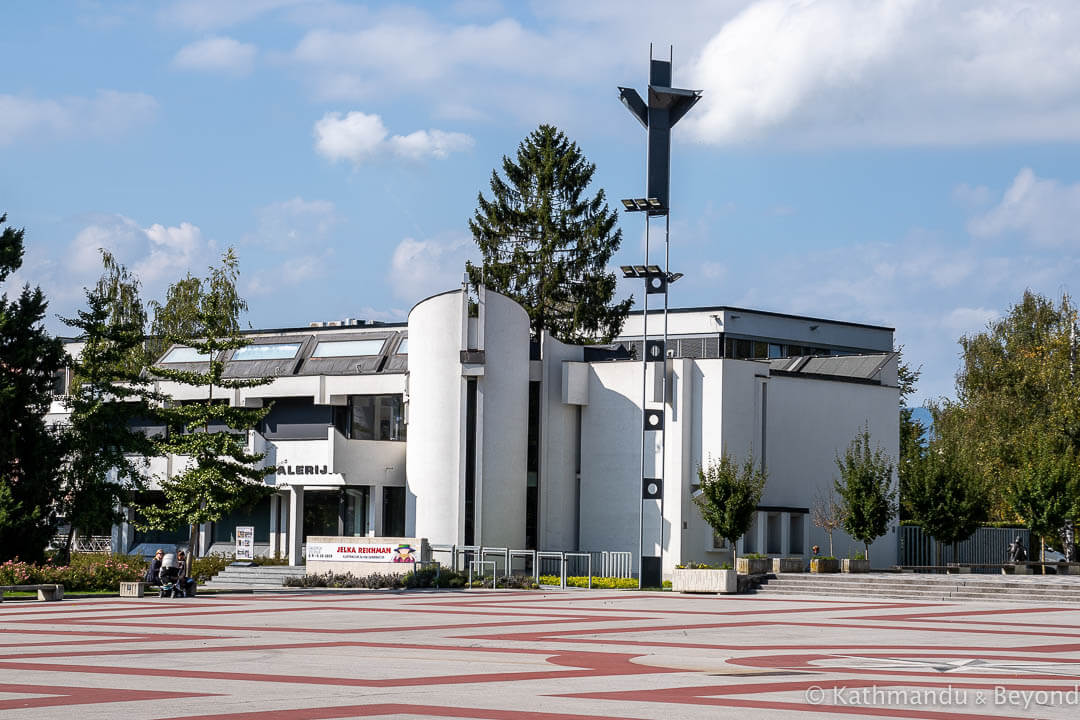 Public Institution Gallery
Public Institution Gallery
Cultural Centre
Hailed as one of the finest buildings in Yugoslavia when it was completed in 1959, the Cultural Centre, or Dom Kulture, is the square’s most imposing edifice. The batik-style relief on the exterior of the building is called “Muse of Art”. It was added one year later and was the work of Stojan Batič, a Slovenian sculptor who was renowned for depicting scenes from Slovenian history. He is responsible for about forty socialist-era public monuments throughout the country, including six more in Velenje. Divided into three vertical sections, the relief on the front of the Cultural Centre symbolises fine arts, music and drama.
To the left of the main entrance to the Cultural Centre is a monument entitled “Mother with Child”. It was completed in 1982 and is also the work of Stojan Batič.
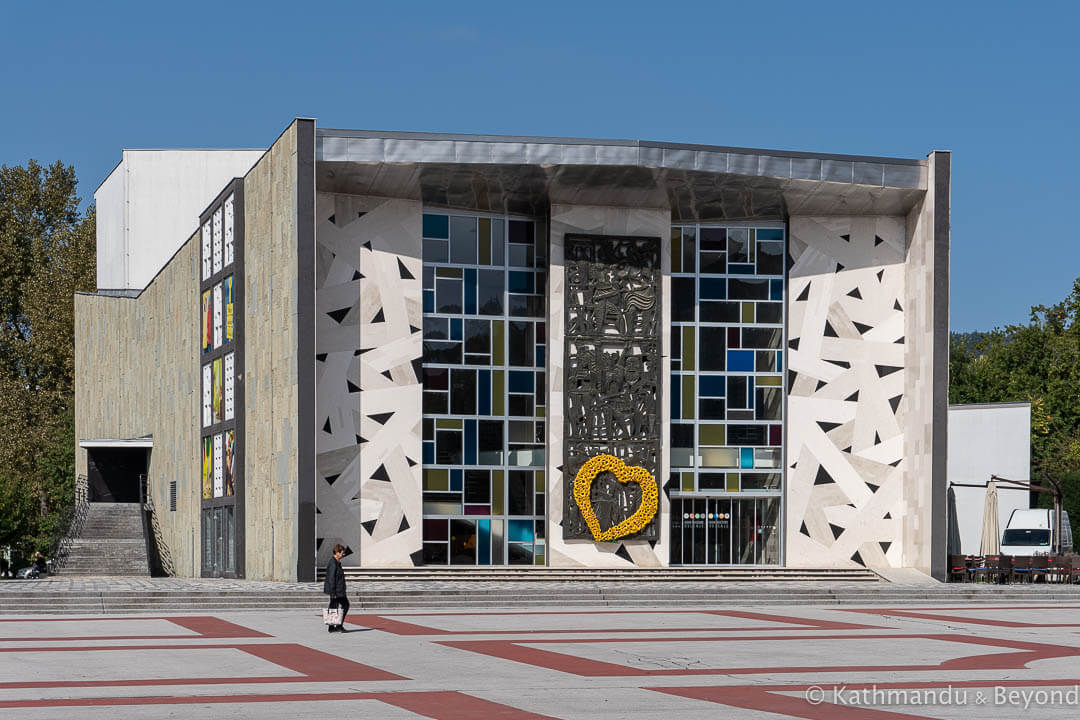 Cultural Centre
Cultural Centre
“Miner” Monument
Partly obscured by trees, the “Miner” Monument in Velenje is rather unimposing given the important role miners played in putting the city on the map. It was the first public sculpture to be erected in Velenje after the Second World War and is one of a pair of miner statues created by the same sculptor, Alojz Kogovsek. The one in Velenje (erected 1953) is the smaller of the two, whilst the larger one (erected 1950) stands on the edge of Tivoli Park in Ljubljana, which can be seen on our suggested alternative walking tour of the city. It strikes me as odd that the larger of the two was places in Ljubljana, given that the city has no connection to mining as far as I’m aware. Perhaps it was the capital’s envious streak towards Velenje, that I touched on above, coming through …
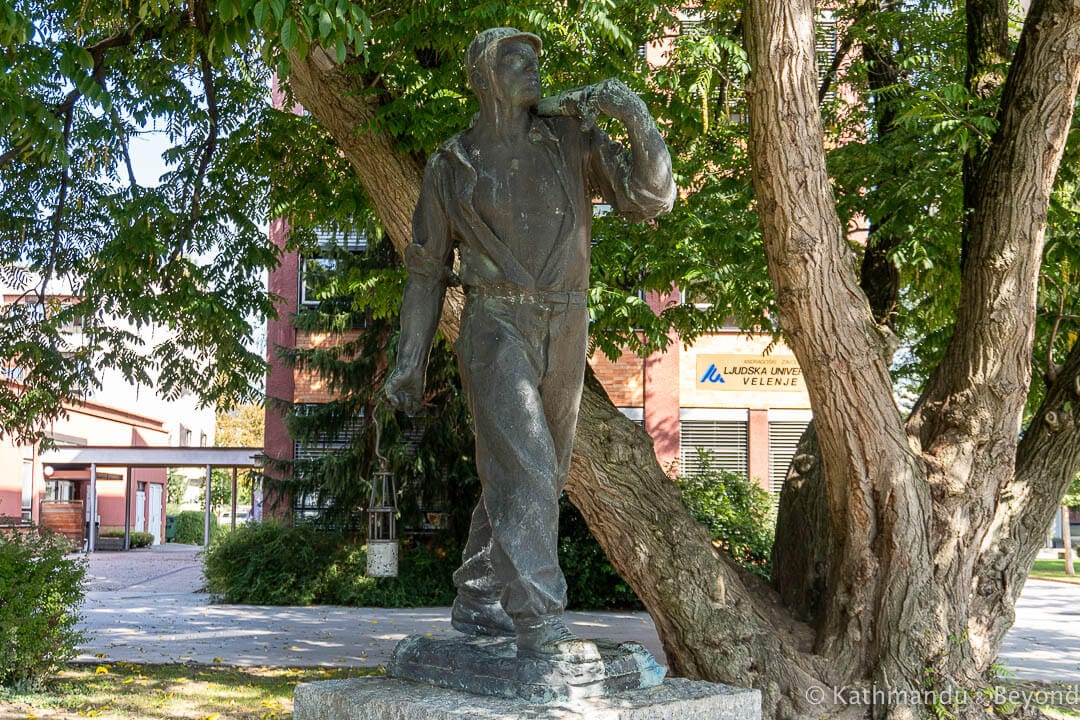 “Miner” Monument
“Miner” Monument
“Speechless Rifles” Monument
Representing upside-down rifles merging into a composition of male and female figures, this spomenik (Tito-era World War II-related monuments and memorials), which I’ve also seen called “Fired guns”, is dedicated to 668 partisans and victims of fascism in the municipality of Velenje. The general architectural arrangement was the work of architect Vladimir Braco Mušič, but the main sculpture was again by Stojan Batič. The architectural part of the monument was radically altered in 2003 at the behest of the Municipality of Velenje but the actual sculpture was left unchanged.
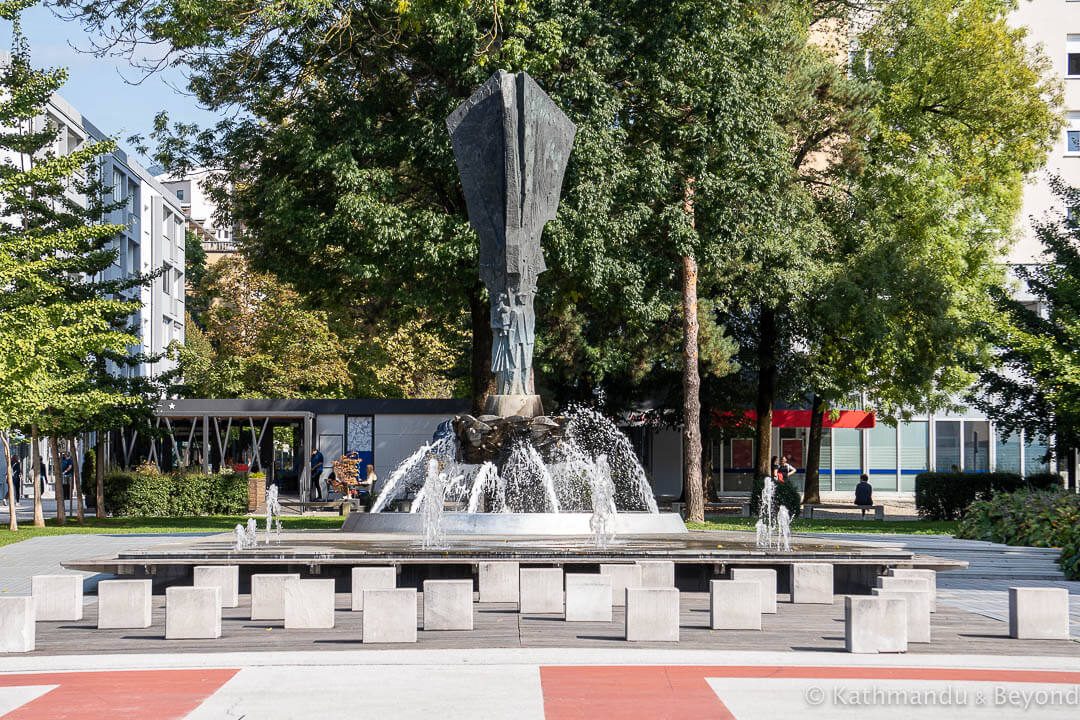 “Speechless Rifles” Monument
“Speechless Rifles” Monument
Municipality of Velenje
On the opposite side of the Cultural Centre, is the city’s unremarkable municipality building, which was added to the square in 1959.
The Miners’ Tower Block
This is the final location of interest on Tito Square. It was constructed in 1961 to accommodate miners and their families. The stairs and lift are in the middle of the structure and the housing units are symmetrically arranged around them. On the roof of the building is a large hammer and pick, the traditional symbol of mining.
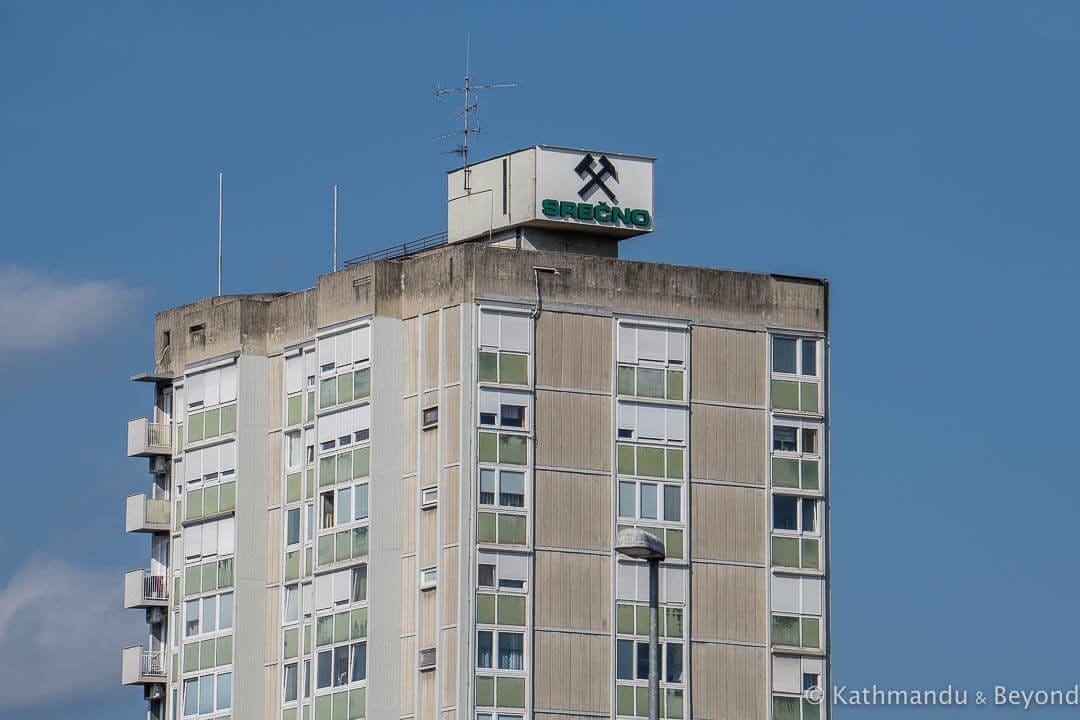 The Miners’ Tower Block
The Miners’ Tower Block
Other sights in Velenje away from Tito Square
It is worth wandering away from Tito Square in Velenje as there are couple more buildings and monuments that are worth seeing.
“Partisans” Monument
This interesting spomenik is located a little east of the Cultural Centre. It was created in 1977 and commemorates both Yugoslav and Italian partisans who fought against fascism during World War Two. The sculptor, Valerio Miroglio, was Italian and it is the only monument in Yugoslavia to be created by a foreign artist.
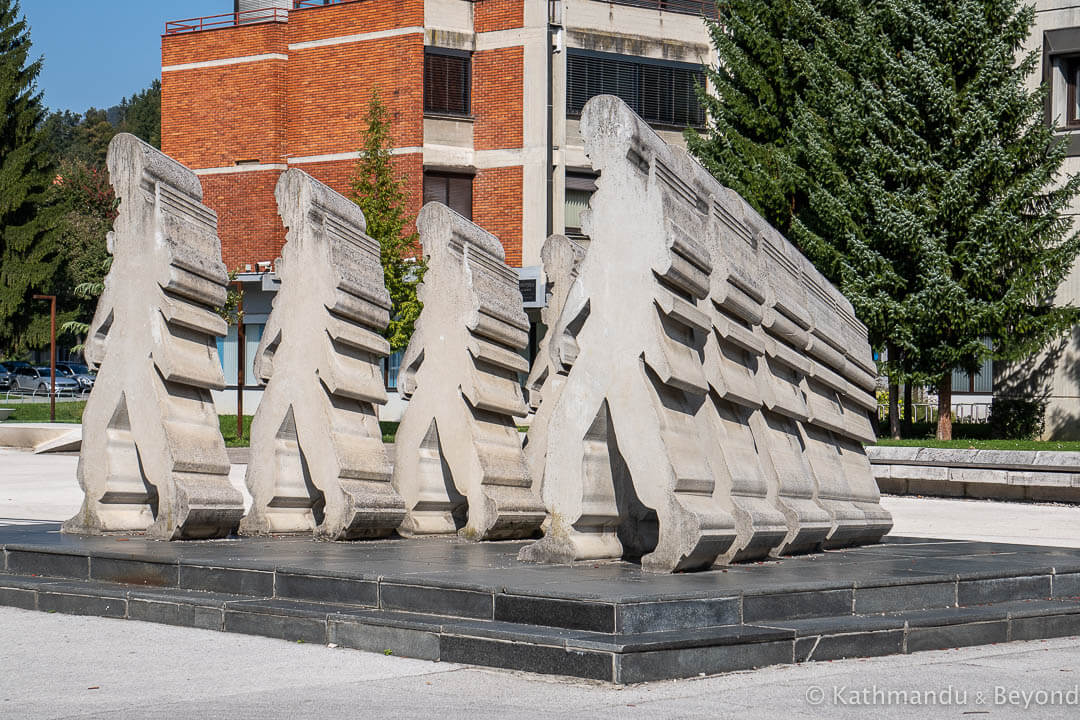 “Partisans” Monument
“Partisans” Monument
Velenje Health Centre
While at the “Partisans” Monument, it is worth walking the short distance directly north to see the modernist aspect of Velenje’s health centre. Although the health centre dates back to the same time as many of the city’s other new buildings, it has been renovated fairly recently and so I’m not sure if the facade is original or not.
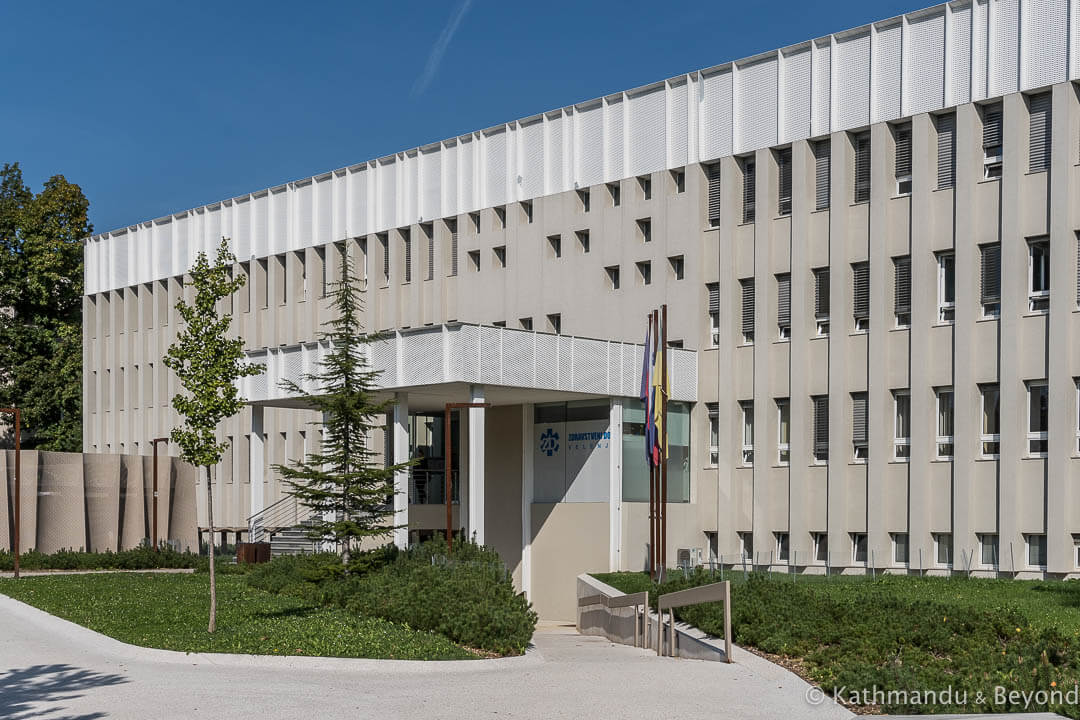 Velenje Health Centre
Velenje Health Centre
Telecom Centre
East of Tito Square, the Telecom Centre is another building worth looking for if modern architecture is your thing.
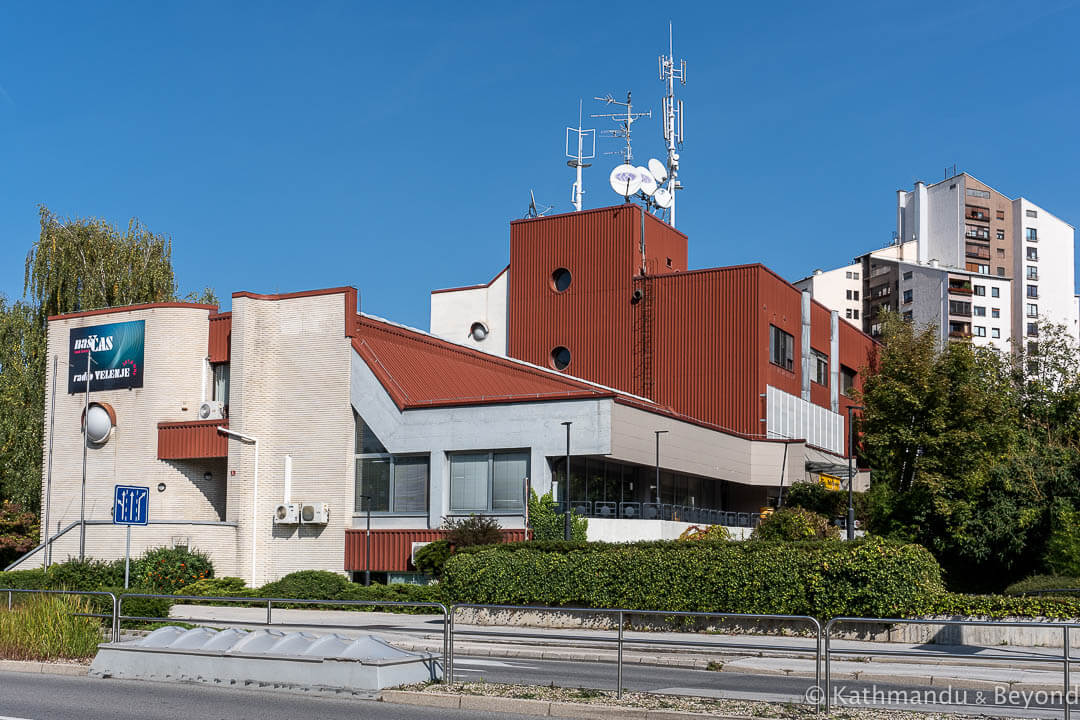 Telecom Centre
Telecom Centre
Socialist-era housing
As well as the Miners’ Tower Block, two other apartment buildings in Velenje caught our eye. Although I can find zero information about either of them, I’m assuming they were both erected in the 1960s and were part of the original template for the new city. It is also obvious that the units have been renovated/looked after in recent times because both are in pretty good shape and not as shabby as numerous others that we have seen in this part of the world. One of the apartment buildings is located northwest of the square near the Paka River, while the other is not far from the Miners’ Tower Block and close to the city’s main roundabout. Both are within walking distance from the square and are marked on the map.
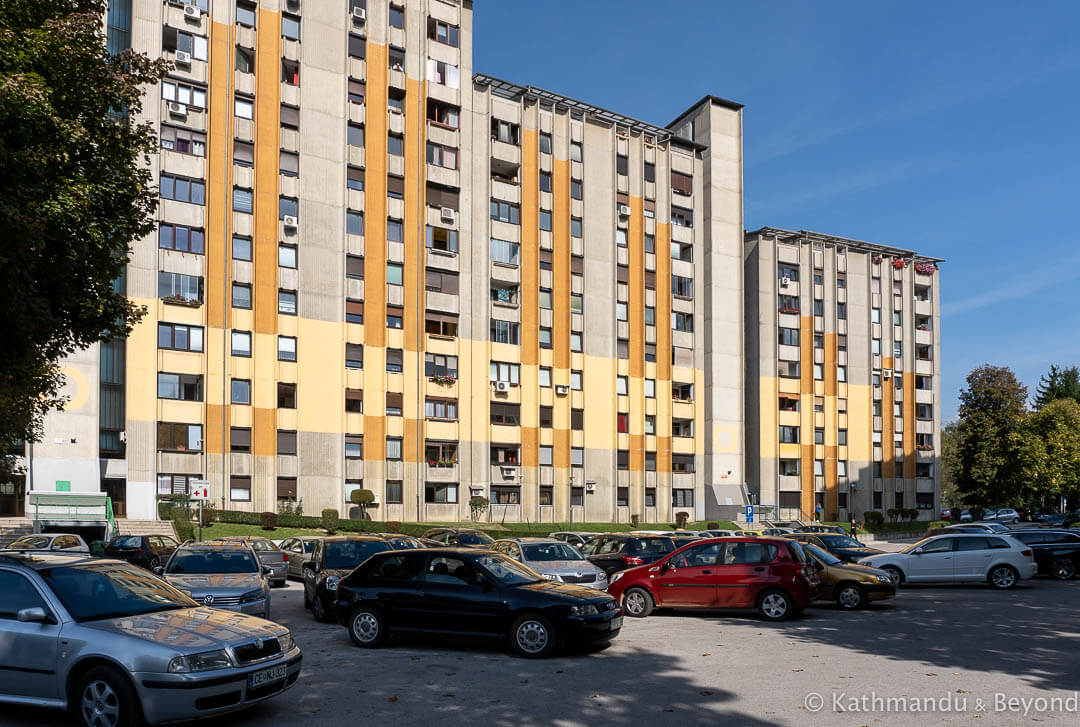 Apartment building near the Paka River
Apartment building near the Paka River
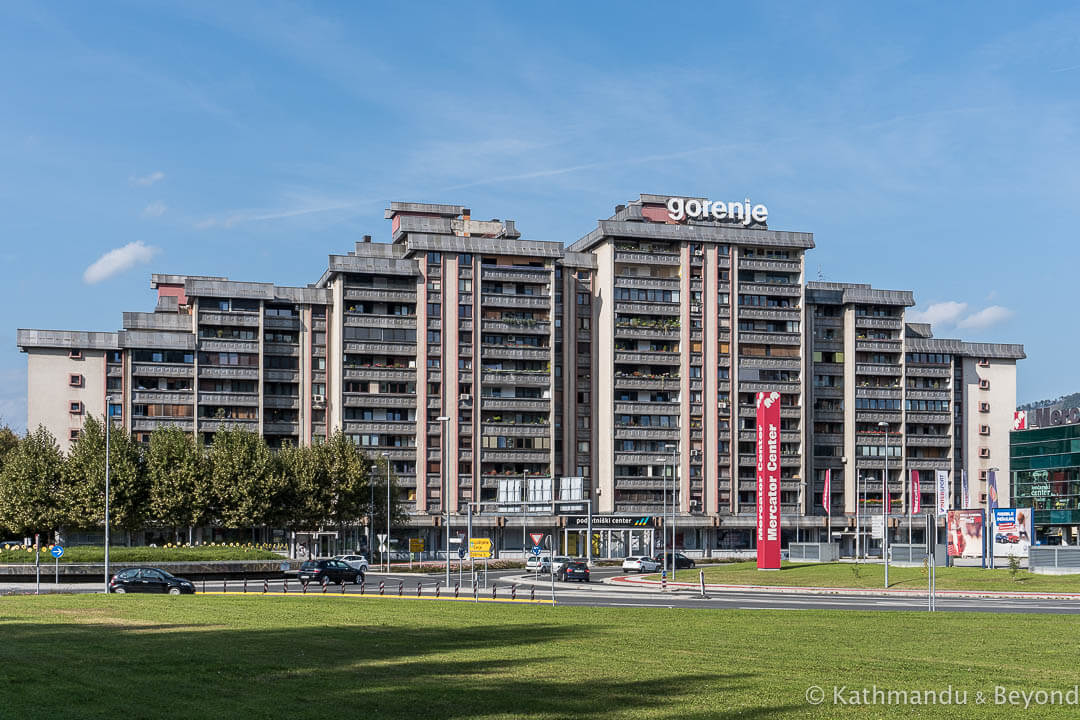 Apartment building near the roundabout
Apartment building near the roundabout
Finally, there are some conventional sights in and around the city, such as Velenje Castle and the Coal Mining Museum of Slovenia as examples, but, we aren’t very good tourists these days and didn’t see any of these and so I’ll leave it to the Tourist Information Centre to promote the more traditional delights of their municipality.
How to get to Velenje on public transport
Velenje can be visited as a day trip from Ljubljana and Maribor as it is almost equidistant between both cities (approximately 75km from either). It is possible to visit Velenje by public transport, although considering its proximity, it’s not as easy as you would think. Alternatively, if you are travelling en route between Ljubljana and Maribor (or vice versa) then Velenje is a decent place to break the journey either for a couple of hours or even for an overnight stay.
By Train
Unfortunately, there isn’t a direct train linking Ljubljana and Velenje and the journey requires a change in Celje. There are reasonably regular departures without too much waiting around in Celje; including connection time the journey takes around 2½ hours.
It’s a similar scenario between Maribor and Velenje – change in Celje for comparable journey times. Fares for both sectors are approximately €8 per adult each way. You can check the schedule on the Slovenian Railways website.
By Bus
Bus times are shown on the Nomago website, although it’s not always that easy to use. You can check the bus schedules for buses departing Ljubljana for Velenje here.
Note: Although we are usually advocates of public transport, in the case of our visit to Velenje we hired a car from Ljubljana airport to explore some of Slovenia’s harder-to-reach spots. Driving in Slovenia is relatively stress-free and the road are good so car hire is worth considering especially if you are short on time.
How much time is required to see Velenje
Assuming you’re just here to see the city’s socialist-era landmarks then two hours, three tops, will be plenty of time to take them all in.
Where to stay in Velenje
Because of the short distances, there’s no need to overnight in Velenje unless you really want to. That said, if the bus and train times aren’t suitable, it would allow for a more leisurely exploration of Velenje. If you do want to sleep in Velenje, there are several options for various budgets. If you want to continue with the socialist-era theme then the Hotel Paka, which opened in 1961, would be a good bet. It is located within spitting distance from square and if you request a street-facing room then you may even get a backside view of Tito’s flowing trench coat!
READ MORE BLOG POSTS FEATURING SLOVENIA
DO YOU ENJOY GETTING OFF THE BEATEN PATH? PIN THIS POST TO YOUR TRAVEL BOARDS…
